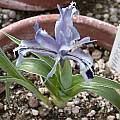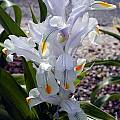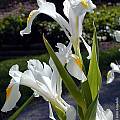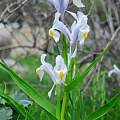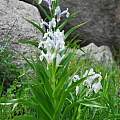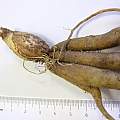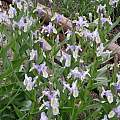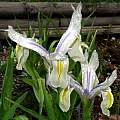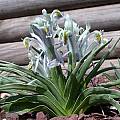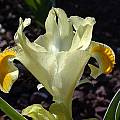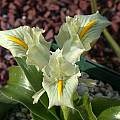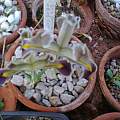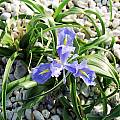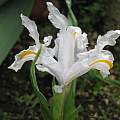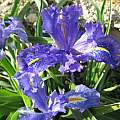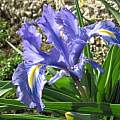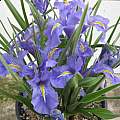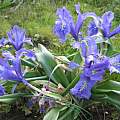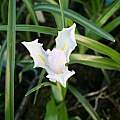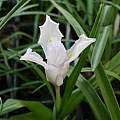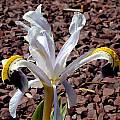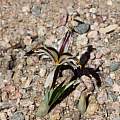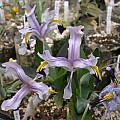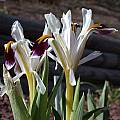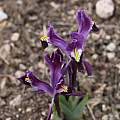The Junos make up the largest group of bulbous irises with around 60 species. Officially the subgenus 'Scorpiris', they form a natural group characterized by their bulbs which are somewhat fleshy and have from a few to several thick, also fleshy storage roots. Except for a single Mediterranean species, most occur from the middle east to Central Asia, but none quite get to China. Some species are hardy and easy to cultivate as far north as Canada, while others are very tender even in English gardens. All are dormant in summer, and produce foliage either in mid-winter or early spring. Culture is variable, but good drainage and summer dormancy are common requirements. Some species demand copious water in spring, others far less. Check specific care for each species. This information provided by Jim Waddick. Species and cultivars J-R found on this page.
Iris kuschakewiczii B.Fedtsch. is from the northern foothills of the Tien Shan Mountains in Central Asia. This is one of the smaller Juno irises; the specimen shown is about 4 inches/10 cm tall including the flower. This plant was grown from a very small bulb/rhizome given me by Harvey Wrightman two years before the photo was taken. It is in a bulb frame, kept dry in summer. Photo by Jane McGary.
Iris magnifica Vved. is an impressive Juno from Central Asia that can reach to two feet (30-60 cm) in height. Normally the lilac flowers can protrude from the top ten leaf axils and put on quite a show. This species is one of the easier ones to grow in the open garden in a well drained sunny position. Seeds should be soaked until thoroughly hydrated to remove possible germination inhibitors. Sow hydrated seeds in 50:50 compost and sand and covered with a fine course gravel. Either stratify the seeds outdoors in the winter if you live in a cold climate (-5 to -10 °C, down to -20 °C) or place in the refrigerator for several weeks to months. It may take many months to germinate if stratification is not complete. This species is not recommended for the warm climate of southern California. Seed sowing information gathered from a PBS post by Iain Brodie. Photos 1,2 by John Lonsdale, photos 3,4 by Oron Peri of the species in its habitat in Uzbekistan. Photo 5 by Peter Taggart shows the bulb has thick roots.
Iris magnifica 'Agalik' is a hardy cultivar that grows 40-60 cm (16-24") collected by Jánis Rukšáns in the Serawschan Range of Uzbekistan in 1977. According to Paige Woodward who supplied the photos and the information, this is a vigorous Juno that blooms in April-May, a beauty in both flower and foliage that does well in the open garden. It received the Award of Garden Merit (Royal Horticultural Society) 1994.
Iris narbutii O.Fedtsch. from Central Asia is a short plant of 4-6" (10-15 cm) with yellow styles and yellow and violet falls. The standards are deflexed and bright purple. Photos by John Lonsdale of a hybrid and a cultivar, 'Kara Kaga'.
Iris orchioides Carrière is from the Tien Shan in Central Asia where it grows in harsh rocky places. It has pale yellow tinted pale purple flowers with a yellow raised and toothed crest. Height: to about 30 cm. Photo by John Lonsdale.
Iris palaestina (Baker) Barbey is from the Eastern Mediterranean (Israel, Lebanon coast, Jordan, southern Syria). It is a short species (15 cm) with green flowers. Photo by John Lonsdale.
Iris persica L. is named for its Persian origin, being native to southern and southeastern Turkey, northern Syria, and northern Iraq. It grows only 4 inches tall (10 cm) and its color is variable: Silver-grey, beige-tan, or gray-green with the blade of falls dark purple or brown. The crest is prominent, yellow, dotted brown or purple (from Iris Summary by Robert Pries). In this photo by Peter Taggart is a flower he grew from some roots from Tony Dickerson, who sourced and sold collectors' bulbs under the name Westonbirt Plants. The roots of junos can sprout like Dahlia tubers.
Iris planifolia (Mill.) T.Durand & Schinz is the only European Juno. It is found on rocky hillsides and banks in Portugal, Spain, Sardinia, Sicily, Crete and North Africa. Height range: 20-30 cm. It flowers early in winter, December and January in habitat and needs good ventilation to prevent disease. Grown and photographed by Rob Hamilton in the first photo. The next four photos show colour variants grown by Angelo Porcelli, the alba form, a dark blue-violet, one with a large white signal and the classic form. Cultivation in pot for this stemless but vigorous species is easy if tall pots of 30 cm (1ft) are used for a good root run, but it performs much better in the ground. In spite of the small size of the plant, the flowers are among the biggest in the Juno section.
These two photos show a pale blue colour variant grown by Roland and Gemma
Iris rosenbachiana Regel is from Central Asia. Flowers are a deep rich purple with a bright orange crest. Height: about 10 cm. Photos by John Lonsdale, Bob Nold, and Jim McKenney who writes: "Here it is blooming in my USDA zone 7 garden in late March, 2006." John Wister, in his 1948 book Bulbs for Home Gardens wrote: "The first of this group (juno irises) to bloom is I. rosenbachiana, coming as early as February in Washington (D.C.)"
Photos below from John Lonsdale and Bob Nold are of the cultivars, 'Harangon', 'Tovil Dara', and 'Varzob'
Iris Index - Beardless iris A-K - Beardless iris L-R - Beardless iris S-Z - Crested Irises - Garden Bearded Irises - Juno iris A-I - Juno iris J-R - Juno iris S-Z - Aril Irises - Miscellaneous Irises - Pacific Coast Irises - Reticulata Irises - Spanish Irises - Belamcanda - Hermodactylus - Pardanthopsis
